Though two different countries, the regions around Pailin (Cambodia) and Chanthaburi (Thailand) have an interrelated history when it comes to politics, mining, and geology.
Separated by about 90 kilometres of road, the two regions consist of several inactive volcanoes and valleys where most of the mining occurs.
Pailin and Chanthaburi are most well-known for rubies and sapphires; however, other gemstones are also found in the region.
Our visit to Cambodia began at the Pailin gemstone market, which consists of several stores near the Phnom Yat Pagoda.
One store is both a gemstone gallery and a restaurant and this is where many of the merchants have breakfast, and which became our ritual for our entire stay in Pailin. We would leave our hotel and head to this restaurant and get a table. After a breakfast of noodle soup, the merchants would bring different parcels of gemstones for us to consider.
Pailin is a quiet town with an equally laid-back market, so it was easy for us to spend several hours at the breakfast table or to head to some of the adjoining stores for an hour or two at a time.
Our team leader, Vincent Pardieu, would use these opportunities to share a some of his wisdom about the local trade and offer insight into the gemstones. We saw many parcels of low-grade corundum, small sapphires and rubies that had poor colour and clarity.
Around 2002, gemstone burners in Chanthaburi discovered how to treat the poorly coloured corundum with heat and the chemical beryllium to change them from cloudy bluish-red to clear, glowing orangish-red beauties.
The treatment gave the stones a fresh breath of life and in turn reinvigorated the mining region, as they possessed a significant amount of previously worthless stones now worthy of trading.
We ventured into the protected jungles inside the Samlot district to see what we could find and observed a truck from the Halo Trust, a group that is working to find and remove landmines that injure and kill hundreds of people each year.
It was a good reminder of how careful we had to be while trekking through the jungle. Any aimless straying from the direct roads and paths could end in tragedy.
When we reached our first destination, we were greeted by a Cambodian military officer. He guided us through a jungle path to a river which we had to cross via a small canoe.
From there, we continued along the path until we reached another river where we encountered two miners. One of the miners was 72-years-old and proudly told us that he was the oldest miner in the area.

It appeared that while the land is protected from mining by the MJP Trust, the local custodians have given permission to a handful of artisanal Cambodian miners to work.
As long as the mining groups are small, spread out, and don’t harm the environment, the conservation group allows them to earn their living this way.
The technique we witnessed was one of the most simple and ancient methods of mining. The miner gets into the cloudy yellow river which is about waist high with a sifting bag and a fine straining basket.
He sifts through the dirt and mud at the bottom looking for precious stones. He fills his sifting bag with rocks and mud from the bottom and then pours that into his basket, where he shakes and rinses it in the water.
Periodically the basket is lifted to see if anything colourful has been recovered. This is a very slow method of mining, but it costs the miners nothing but their own time, so it’s a low-cost way for locals to earn a living.
After departing, the soldier took us to another site that was about ten minutes away on foot.
We met two more miners who were sifting through small pits that they had hand-dug in the hunt for gemstones. We purchased about 15 pinkish rubies from one of the miners, which he said was his yield from the previous week.
We continued via motorbike and arrived at a third mining site that was being used by one miner - another alluvial deposit in a river. I was told that this area had already been mined heavily in previous decades.
The path along the river was littered with rubble and boulders that had been pulled out of the water by previous miners. We walked along this rocky path until we found the spot we were looking for.
A lone miner was situated in the water in a similar fashion to what we had seen earlier in the day, using a basket and tray to sift the rocks and mud looking for precious gemstones.
He had been working all morning and was getting tired but was happy to let us watch him work for the remainder of his work day.
Afterward, he showed us what we had found recently, and we got to see smaller pinkish-red ruby specimens that we were learning is typical of the area.
At a small jungle house, we looked at our final few parcels of local gemstones while the wives prepared dinner for the miners. We inspected several parcels. New bags of gemstones kept appearing from unseen pockets as soon as the previous ones were purchased!
Visiting Pailin Market
We decided to spend our second day inspecting the market to see what kind of gemstones people had been buying from the local miners in the past few months and spent time comparing the unheated rubies with beryllium-treated stones and reflecting on what it meant for the gemstone industry.
One moment that I particularly enjoyed was a visit to a store that had workers faceting rubies and sapphires.
As a gem cutter, I am always interested to see people of different cultures cut in their unique way. These workers had the gemstones attached to a dop with wax and the dop was attached to a wooden handpiece, identical to the type we see in Thailand.
The handpiece, like a simple version of a Raytech-Shaw/Imahashi hand piece, would let the gemstone freely rotate. It didn’t have indices but the faceter seemed to know how far to rotate the stone to get the index he wanted. With this method, he could also adjust the angle of the stone.
It was great to get to see such a wide variety of corundum from the region. We also saw a lot of stones that weren’t from the area. Those were interesting for the purpose of contrasting and comparing to the local corundum; however, for our purposes, we weren’t interested in buying gemstones from other regions.
We spent time going back and forth between the natural rubies and those that were beryllium treated. In many examples, you can easily see how the natural stones have too much blue in the red to really be called rubies and to be profitable.
The beryllium treatment removes a lot of the blue from the gemstones leaving them with an orangish tint. The treatment also heals the fractures in the rough meaning there is cleaner stone to cut. In general, you end up with bigger cut gemstones than what would not have been possible with the unheated material.
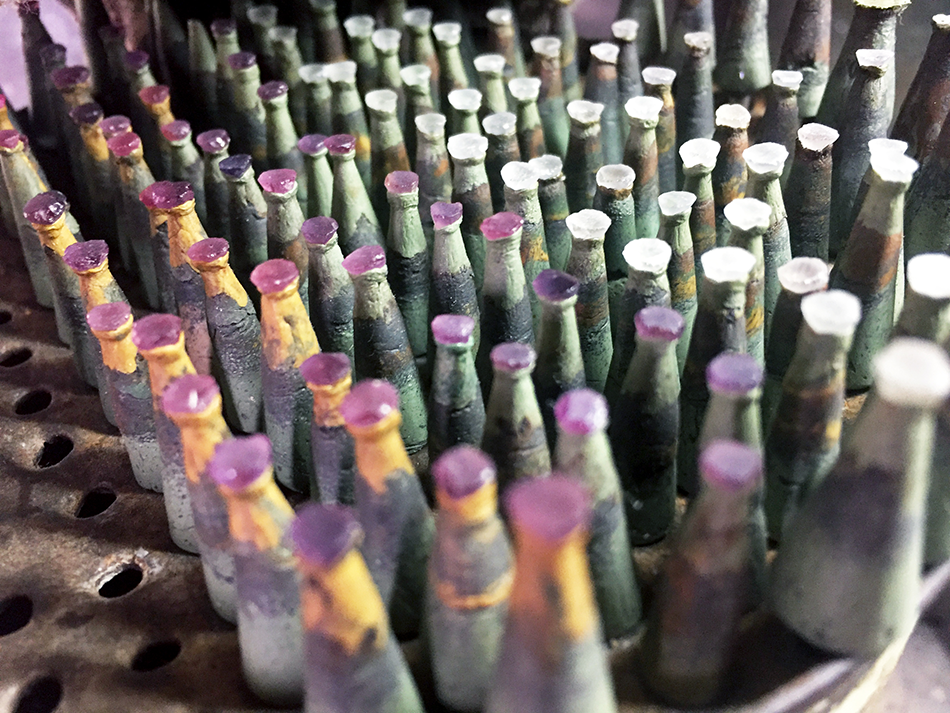 |
| Remarkable artisans: The gemstone faceting process in Cambodia. |
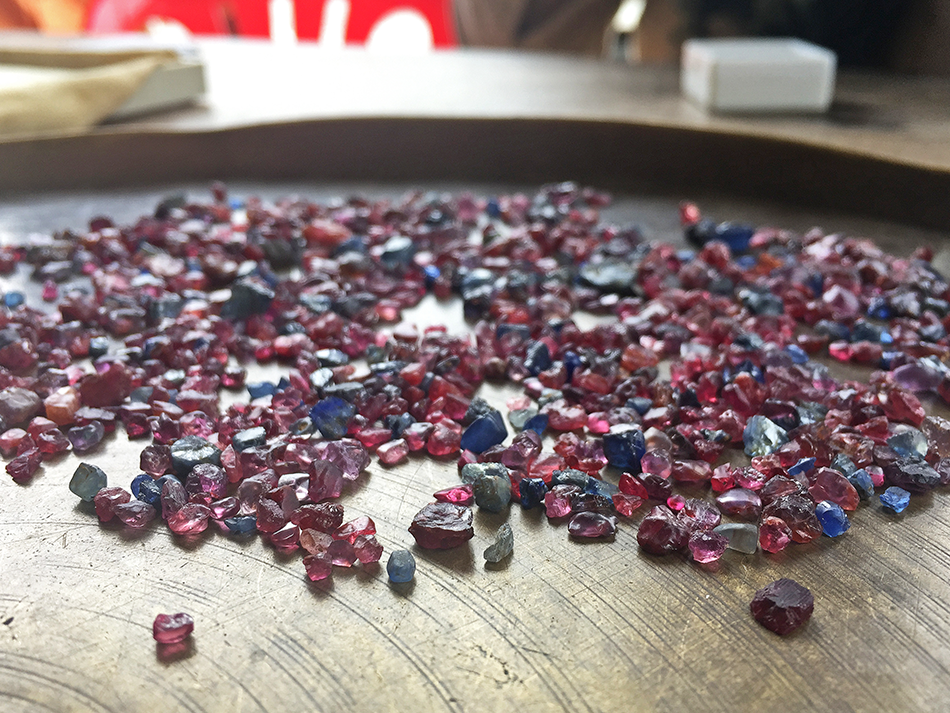 |
| Rubies and sapphires await faceting in Cambodia. |
 |
| Beautiful landscapes: The eastern view from the top of Khao Ploy Waen. |
Phnom Yat Temple
As we left the market, we decided to pay our respects to the Phnom Yat Temple. We crossed the street and trekked up the numerous stairs that lead to the top of the sleeping volcano.
This temple is important for the history of rubies and sapphires in Pailin. One of the first things you see when you get to the top is a statue of a golden otter playing with a piece of rough.
The local legend suggests that Burmese merchants were hunting in the forest when they saw an old woman who greeted them. They didn’t know it at the time, but this wasn’t a woman, it was a nature spirit named Ye Yat.
She told them that they shouldn’t kill the animals and that instead if they travelled down to the river they would see something that would give them a better livelihood.
Once at the river, the migrants saw two otters playing with shiny stones, one blue and one red. The migrants knew what the stones were, and they started digging, finding more and more ruby and sapphire.
There is also a small temple to the nature spirit woman, Ye Yat. The locals take offerings to her as a mark of gratitude for her role in guiding their ancestors to the lucrative gemstones that provided their families with wealth for generations.
Saying goodbye to Pailin
On our final day in Pailin, we had breakfast at the market and then headed to one last mining site - it wasn’t too far from the town centre.
By the river, we discovered two miners sitting in the river looking for stones. This was a rare example of a mining site that is renewable. The miners have dug pits in the middle of the river with a ring of rocks around it so that as the river current passes their pits, the heavier rocks would drop.
The miners use a shovel with a long handle to pull a pile of rocks from their pit and put them in sifting baskets. They only mine in the river during the dry season because during the rainy season, the water is too deep and safety is a concern.
The miners exited the water and showed us the collection of stones that they had found in the past few weeks. Both were in good spirits and smiled and laughed as we negotiated prices for their findings.
We were able to get samples from both men and also hear stories about life as a miner. It wasn’t all laughter – we were told a horror story of a miner losing his foot. The miner once worked a job harvesting bamboo, however; he stepped on a landmine. Now, he must walk with a large stick and there are many jobs he is unable to do.
Luckily, he discovered that he could earn a living as a river miner.
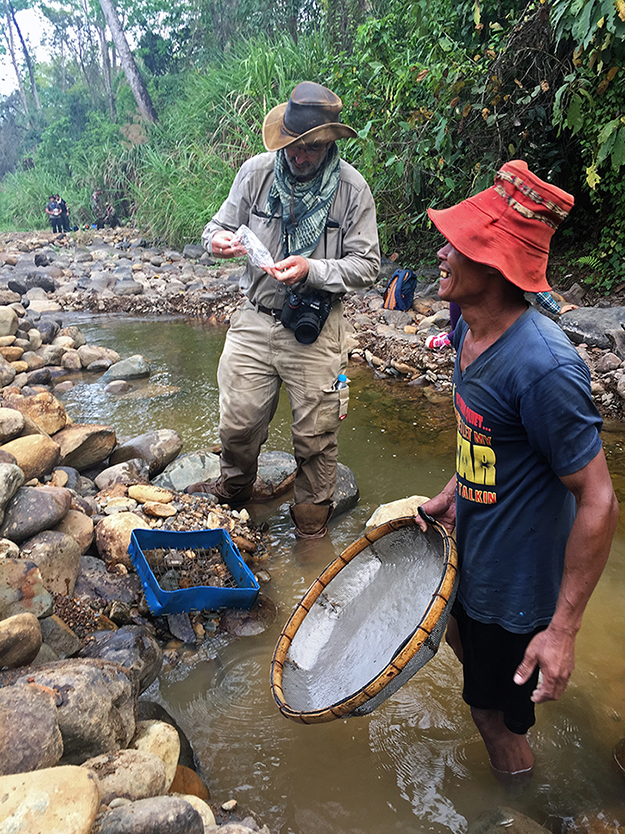 |
| Gemstone miner showing Vincent Pardieu his ruby collection in the water. |
 |
| A regional miner searches the water for gemstones. |
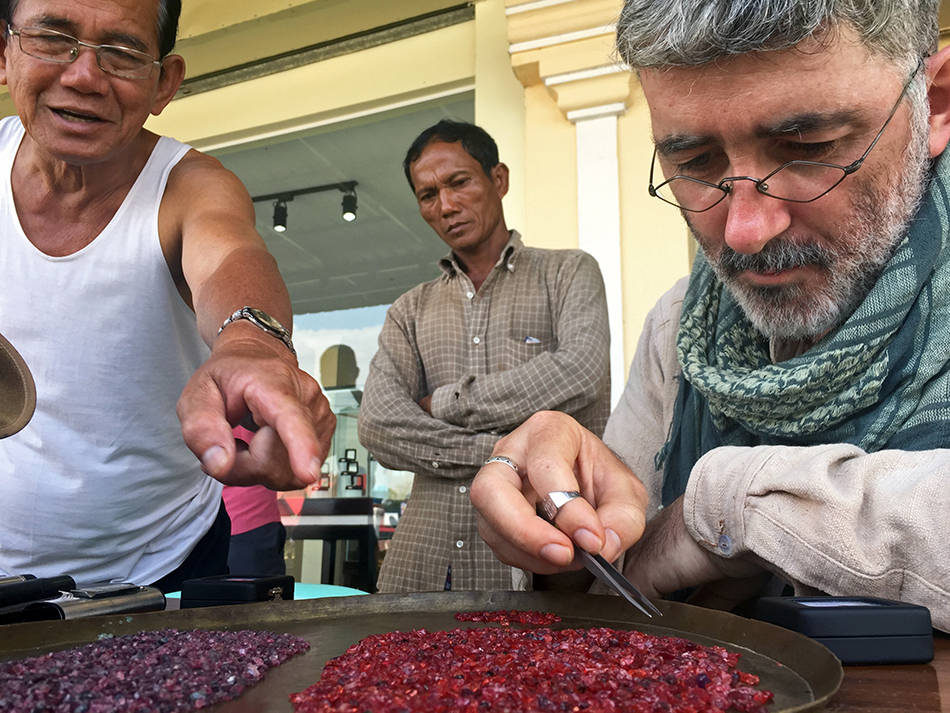 |
| Time for an inspection: Local Pailin unheated rubies on the left, and rubies with beryllium treatment on right. |
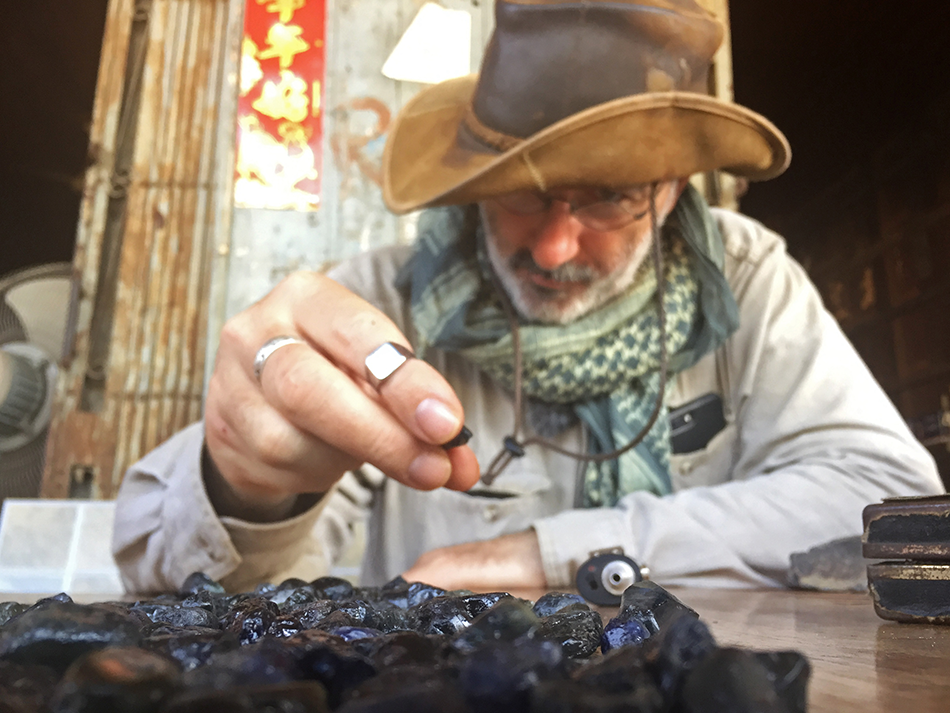 |
| Tour guide Vincent Pardieu inspecting a parcel of sapphires. |
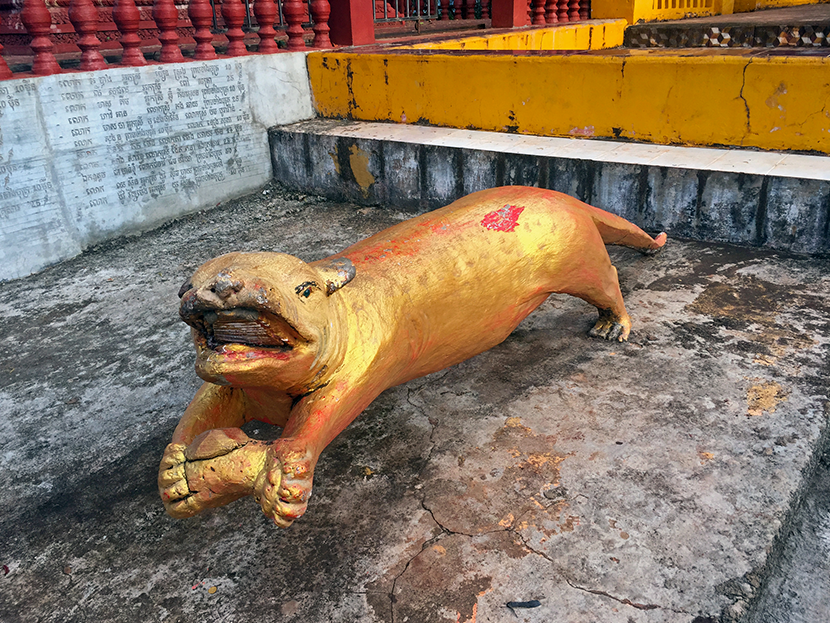 |
| Tradition honoured: The Otter and the Ruby at the Phnom Yat Temple. |
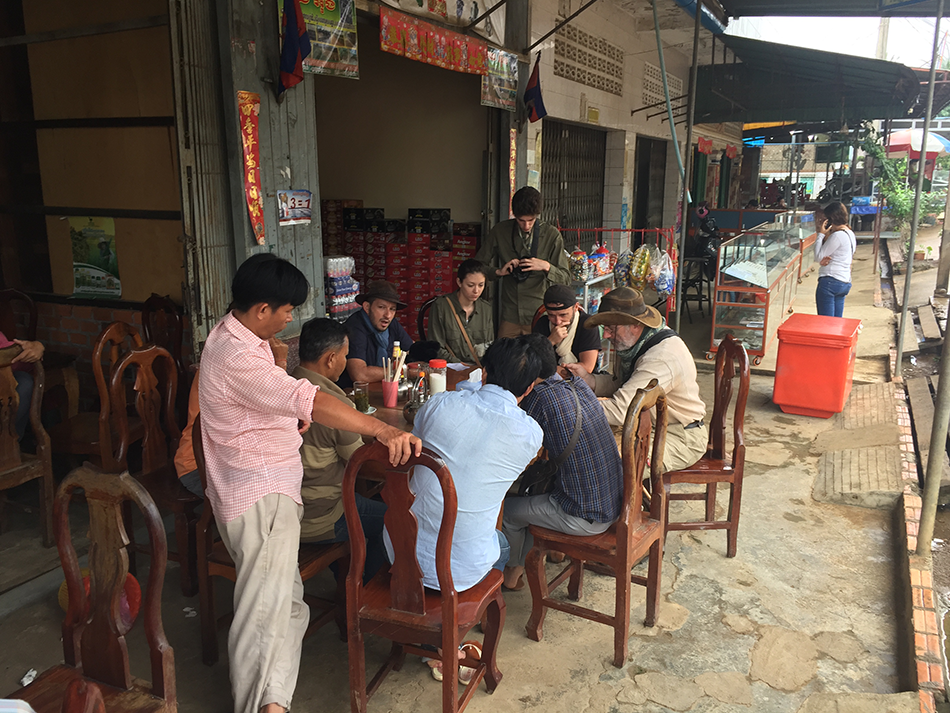 |
| Gemstone deals around the breakfast table in Pailin. |
Chanthaburi, Thailand
Our journey to the Chanthaburi side of the border started at the temple on top of the Khao Ploy Waen Volcano.
The name of the volcano translates as ‘mountain gemstone ring.’ The ring around the volcano is the area where you discover the gemstones.
In the distant past, magma from the then-active volcano brought gemstones with it to the surface and then when the magma cooled, it turned into basalt rock.
The corundum was stuck inside the new basalt, and many are etched from their exposure to the magma.
In Burma, temples are constructed on top of mountains to give respect to the spirits of the mountain, prevent earthquakes, and keep the local spirits satiated during mining.
Burma has many earthquakes, and the local people believe they are caused by underground snakes, so they do whatever they can to appease these spirits.
This region of Thailand was settled by Burmese miners, and they brought their customs with them. As a result, Chanthaburi also has mountaintop temples. This hill and temple are sacred to the local people and therefore this hill itself has never been mined.
From the top of this temple, we could see mines all around us. This was a surprise, as we had been told many times that there was no more mining in Chanthaburi.
On our way up to the top, we met a local man who told us that there hasn’t been mining in the area in more than 20 years.
Little did he know that from the top, you could see at least eight working mines if you looked toward the east!
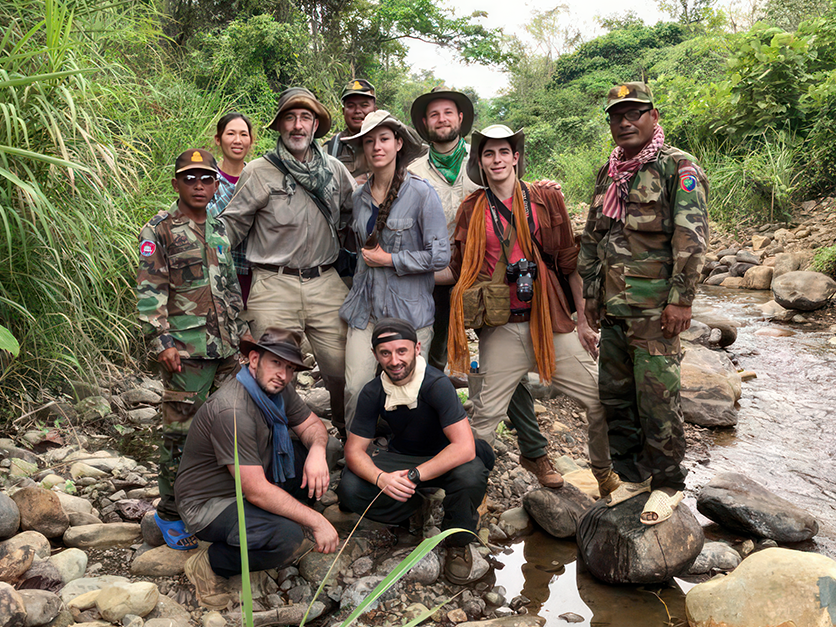 |
| Group photo of the gemstone mining expedition team with three Cambodian soldiers. |
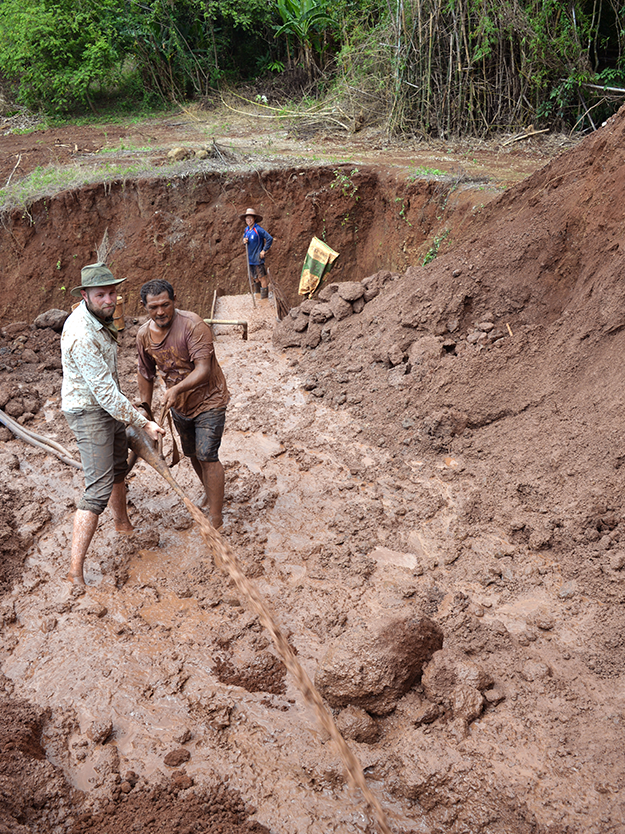 |
| Learning the 'tricks of the trade' from the local mining community. |
Slope of Khao Ploy Waen
The first mine we visited was run by a married couple with one business partner who understood engineering.
The mining land is adjacent to their home, so each year they use an excavator and dig a large hole somewhere around their house.
They spend the dry season sifting through the dirt pile, eventually returning all the dirt back into the hole - minus any sapphires and rubies that they discover.
This time, we participated in the mining process rather than just watching. The mine can be run with just two people - one man shooting the pile of dirt with a water hose and another person on top of the washing plant, keeping big stones out of the pulsating jig that collects the corundum.
In essence, the miners want to liquify the entire pile of dirt and send it through the washing station, however; this takes time, so they attack the hill bit by bit, using recycled rainwater to spray.
The miners invited us to take charge of the water hose and start liquifying the dirt mound. As the water turns to mud, it runs downhill into the washing plant where it gets sorted. The big rocks are pulled out by hand and thrown into the giant pit below.
The excess water also runs into the pit, eventually returning to the top via a water pump. As we traded positions, I took a turn pulling out all the large rocks from the sliding mud so that the miner on the washing plant would have less work to do.
I noticed a flash of gold that I had seen on some other rough from this mine and I pulled it out, revealing a large sapphire. It was a very satisfying feeling!
Our team leader, Vincent, said he had never seen anyone pull a sizable sapphire out of the mud in that manner. We later purchased the gemstone for research purposes.
When the pulsating jig was full, the miners turned off the water and let the washing plant empty. They began sifting through the small pebbles in the machine and pulling out all the corundum and discarding the rocks.
Once finished, we washed up and met near the house. The miners looked at everything that had been recovered and showed us what had been found in the recent weeks.
While looking at all the rough, we learned that there are many star sapphires in the western part of the Pailin and Chanthaburi area.
These stones are large, dark, and have a high concentration of iron which causes needles and platelets to form in the stone, creating the star phenomenon.
Sometimes, the needles and platelets are organised in two different directions, creating two different six-ray stars which makes a 12-ray star.
Depending on the concentration of the trace elements in the stone, sometimes the two different stars are slightly different colours.
In contrast on the Pailin side, there are no needles, only particles which refract light and create a silky-looking gemstone.
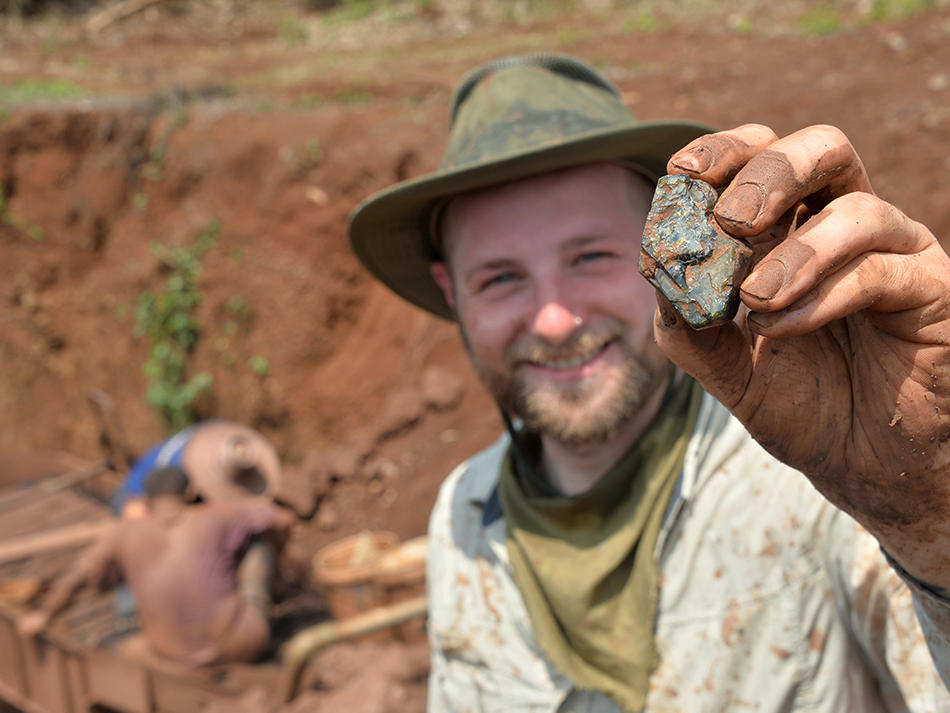 |
| Ready to be cut and polished: Justin K Prim examines a sapphire he extracted from the mud. |
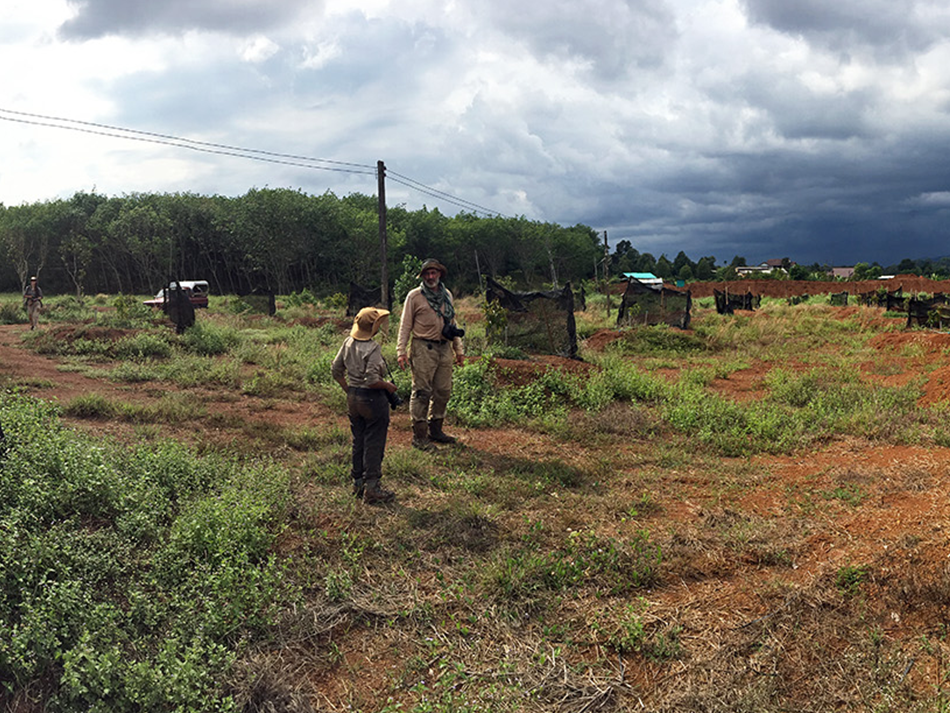 |
| Group discussion: Vincent Pardieu talks with author Kim Rix. |
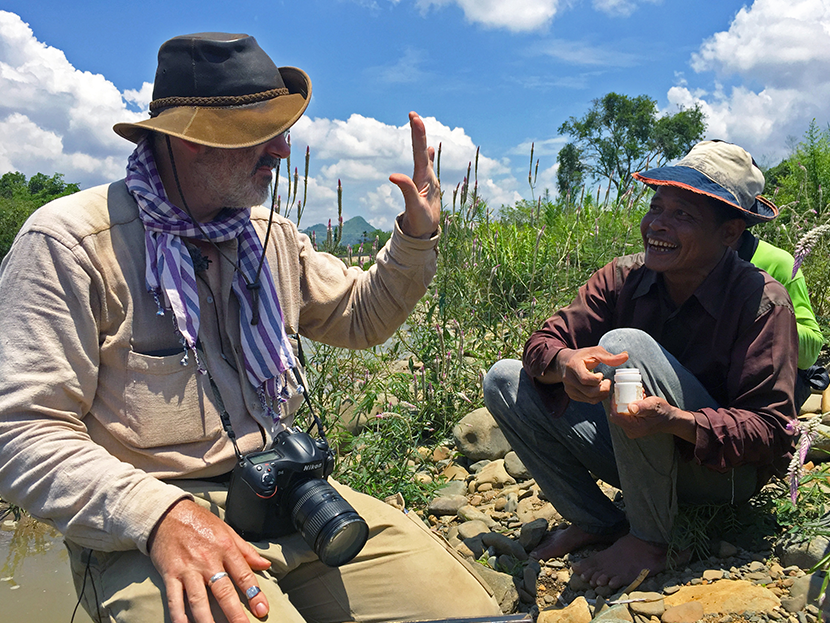 |
| Reasons to smile: Vincent Pardieu negotiates prices with a happy gemstone miner by the river. |
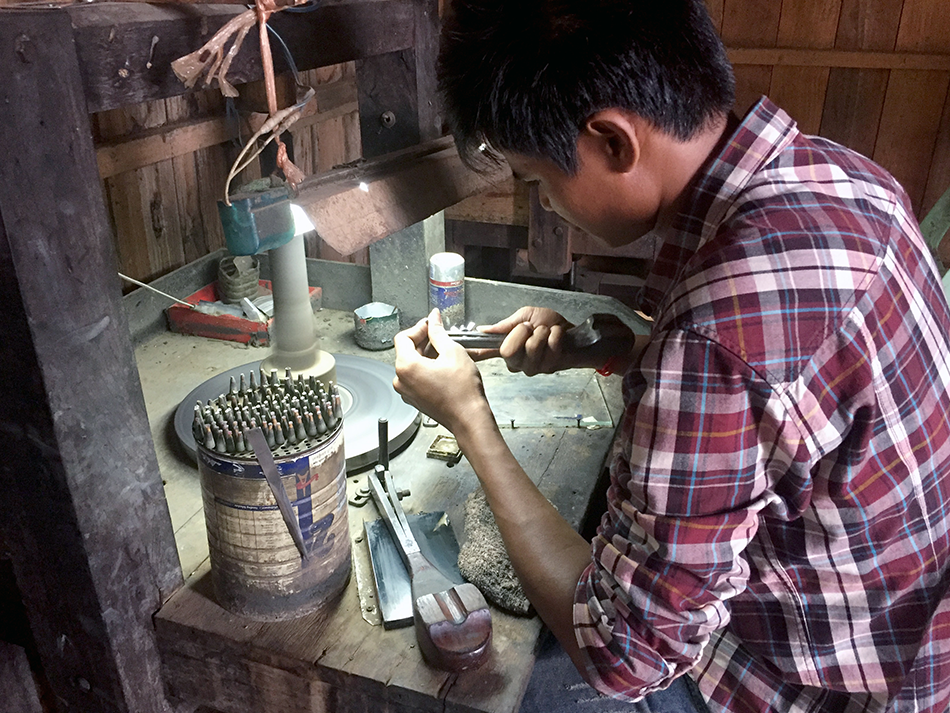 |
| Careful inspection goes hand in hand with polishing the roughs. |
Bon Ka Cha
After purchasing our stones, we jumped in the van and rode to a location known as the Bon Ka Cha mine.
The soil composition of the Bon Ka Cha mine was very different than the previous mine we visited. Here, the miners were discovering gemstones in a layer of pyroclastic ash that rests a foot or two below the ground.
The swampy area was underwater 100 years ago and we discovered marine evidence. Shells of all sizes littered the topsoil.
The scale of Bon Ka Cha was huge compared to the small ‘family mine’ we had just encountered. During the day, we met the owner of the Bon Ka Cha mine – Mr Rainbow. He is a senator for the Chanthaburi government and has been a miner at this location for more than 30 years.
He told us he thinks the mine has five more years of production left in it. He was also ready to start a mining operation in Pailin.
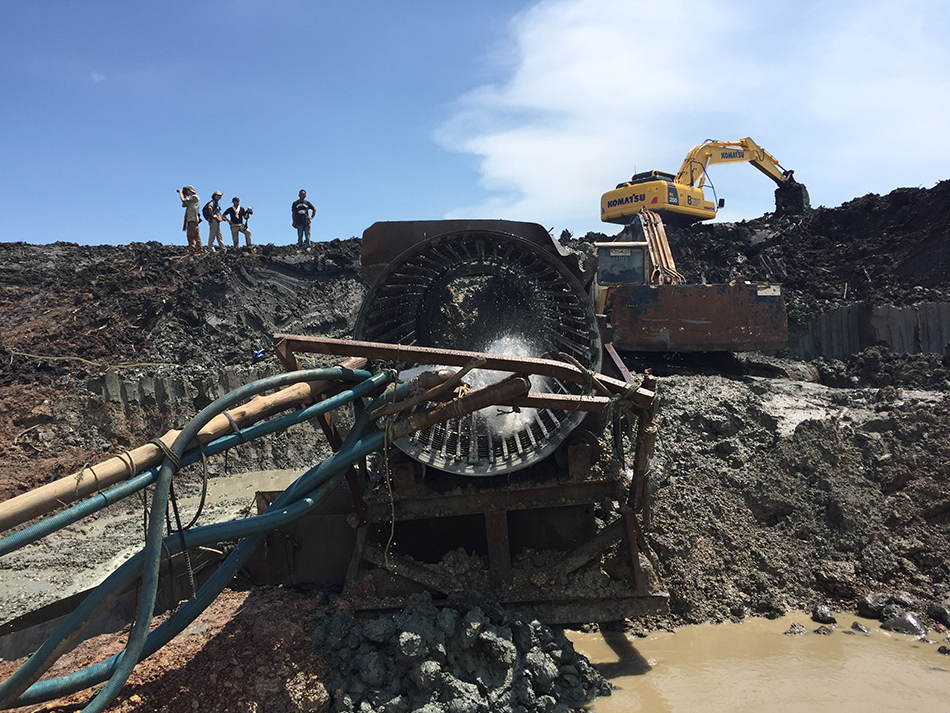 |
| An excavator placing pyroclastic ash dirt into the tromme as the search for gemstones continues. |
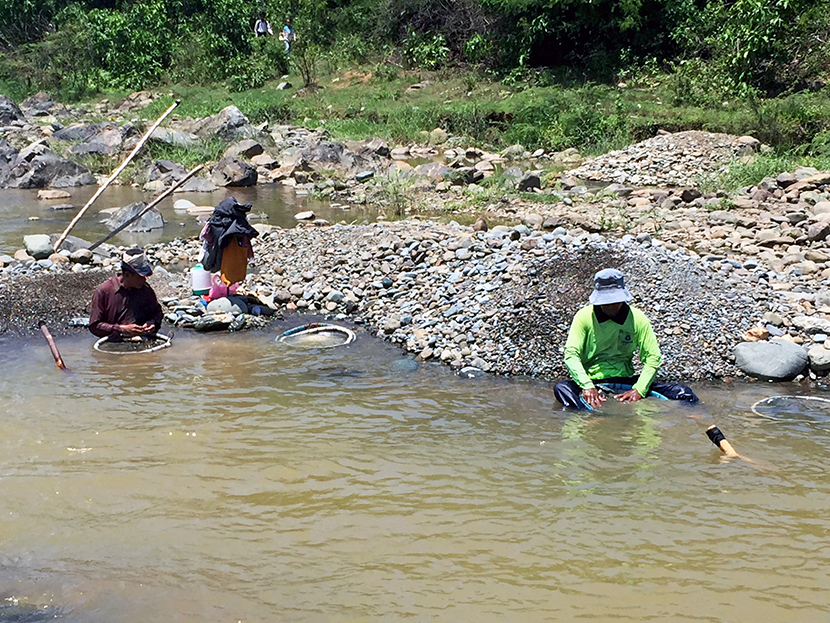 |
| Team work: miners search the water for gemstones as a partnership. |
Rehabilitated mine
The final mine we visited was not actually a mine - it was a field that was once a mine; however, the landowners had filled in the holes and turned it into a banana plantation once the area had stopped producing gemstones.
The site had been transformed into something that was still useful and profitable for the landowners.
This was a great example of a conservation-friendly mining practice.
The land was once used to harvest gemstones; however, it remains important for the local economy. This is a common occurrence in this part of the world.
The volcanic soil that comprises the area is rich in minerals and fertile. The banana is usually the first thing to be planted after mining, as it’s useful for reconditioning the soil and preparing for future crops such as durian, papaya, and dragon fruit.
This mine was our final stop for the expedition. We took our final photos and wrote down our closing notes just before a storm rolled in.
All in all, it was a great trip, an eye-opening adventure, and a success. We learned a great deal, collected valuable gemstone samples, and made new friends along the way.
The author would like to thank expedition leader Vincent Pardieu as well as the expedition team and camera crew: Sovanny Ly, Myriam Buduca, Alexey Yakhlakov, Kim Rix, Didier Barriere, and Anthony Methez.
Read eMag